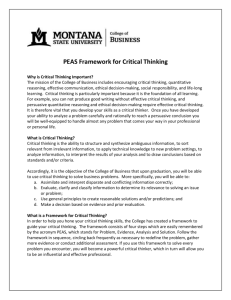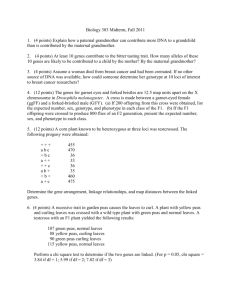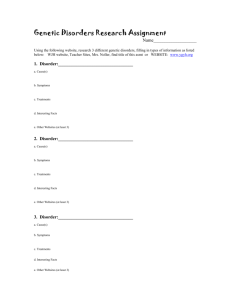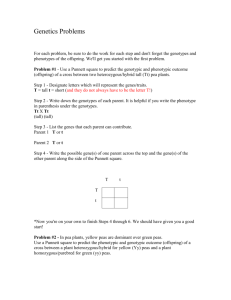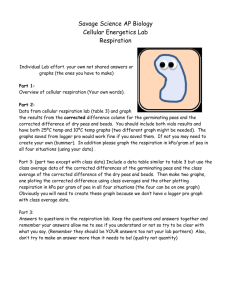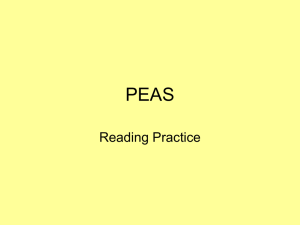Potatoes Royal Soc
advertisement
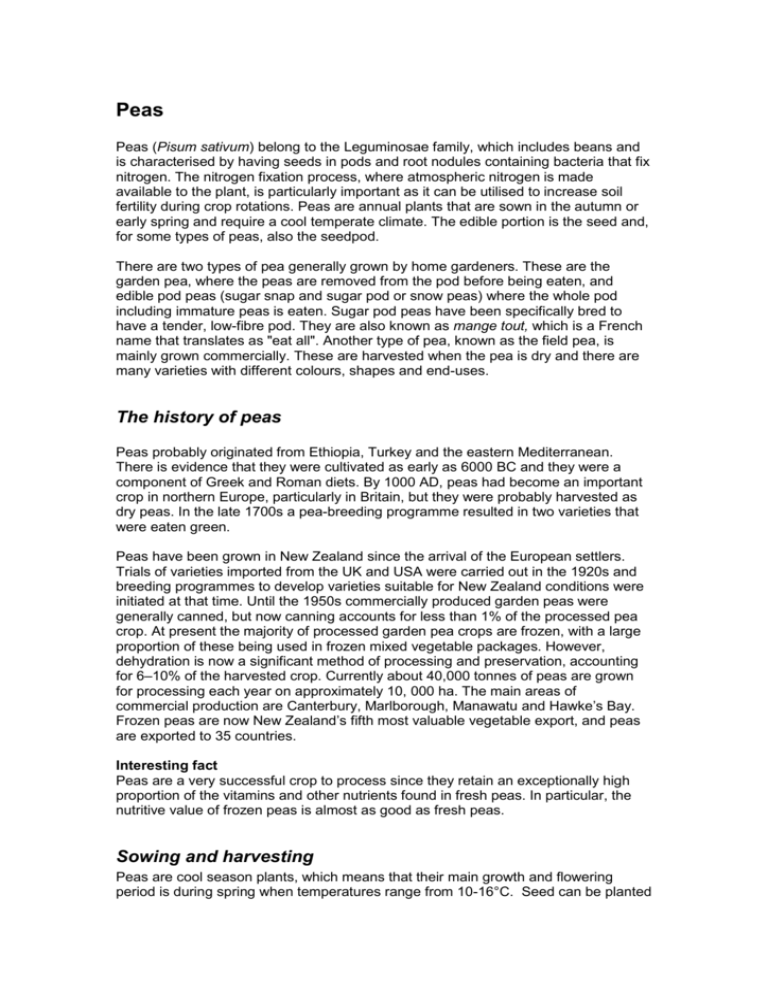
Peas Peas (Pisum sativum) belong to the Leguminosae family, which includes beans and is characterised by having seeds in pods and root nodules containing bacteria that fix nitrogen. The nitrogen fixation process, where atmospheric nitrogen is made available to the plant, is particularly important as it can be utilised to increase soil fertility during crop rotations. Peas are annual plants that are sown in the autumn or early spring and require a cool temperate climate. The edible portion is the seed and, for some types of peas, also the seedpod. There are two types of pea generally grown by home gardeners. These are the garden pea, where the peas are removed from the pod before being eaten, and edible pod peas (sugar snap and sugar pod or snow peas) where the whole pod including immature peas is eaten. Sugar pod peas have been specifically bred to have a tender, low-fibre pod. They are also known as mange tout, which is a French name that translates as "eat all". Another type of pea, known as the field pea, is mainly grown commercially. These are harvested when the pea is dry and there are many varieties with different colours, shapes and end-uses. The history of peas Peas probably originated from Ethiopia, Turkey and the eastern Mediterranean. There is evidence that they were cultivated as early as 6000 BC and they were a component of Greek and Roman diets. By 1000 AD, peas had become an important crop in northern Europe, particularly in Britain, but they were probably harvested as dry peas. In the late 1700s a pea-breeding programme resulted in two varieties that were eaten green. Peas have been grown in New Zealand since the arrival of the European settlers. Trials of varieties imported from the UK and USA were carried out in the 1920s and breeding programmes to develop varieties suitable for New Zealand conditions were initiated at that time. Until the 1950s commercially produced garden peas were generally canned, but now canning accounts for less than 1% of the processed pea crop. At present the majority of processed garden pea crops are frozen, with a large proportion of these being used in frozen mixed vegetable packages. However, dehydration is now a significant method of processing and preservation, accounting for 6–10% of the harvested crop. Currently about 40,000 tonnes of peas are grown for processing each year on approximately 10, 000 ha. The main areas of commercial production are Canterbury, Marlborough, Manawatu and Hawke’s Bay. Frozen peas are now New Zealand’s fifth most valuable vegetable export, and peas are exported to 35 countries. Interesting fact Peas are a very successful crop to process since they retain an exceptionally high proportion of the vitamins and other nutrients found in fresh peas. In particular, the nutritive value of frozen peas is almost as good as fresh peas. Sowing and harvesting Peas are cool season plants, which means that their main growth and flowering period is during spring when temperatures range from 10-16°C. Seed can be planted in autumn (May) but this may have little advantage over early spring (August and September) sowings, particularly if the soil tends to be waterlogged during winter. To achieve the good drainage that autumn-sown peas require, it may be necessary to plant into raised beds. Pea planting can continue throughout spring and early summer (October and November) but yields decrease with later plantings, as the plants flower earlier due to the warmer conditions. In warm areas peas can be grown all year round. Achieving optimal soil conditions prior to planting is very important for obtaining good pea yields. Soil compaction will lead to death of pea plants, so it is essential that the soil be well aerated by digging before planting. Any compost, manure or fertiliser should be thoroughly mixed throughout the soil as young pea roots can be damaged by direct contact with these materials. Soil pH should be around 6.5, which means that lime may be beneficial, especially if the peas are following a potato crop. Because peas can obtain nitrogen through their root nodules, they are often planted into nitrogen-depleted soils, such as after potatoes, and nitrogen fertiliser is unnecessary. Peas can also follow root or leaf crops, but should not be planted after other legumes like beans. Pea seed should be sown less than 50 mm deep in single or double rows. The between-plant spacing is 100 mm for single rows and 140 to 200 mm for double rows. Between-row spacings range from 600–1000 mm, depending on the cultivar’s vine length. The type of cultivar used will also determine what type of rows to sow and the need for staking. Dwarf pea cultivars do not need staking, but growing them over a stick lattice will enhance yield and lengthen their productive life. For the taller varieties, place stakes at the end of the rows and run strings between the stakes on the outside of the rows. This is when double or even triple rows can be an advantage as the peas support themselves on the inside of the rows and staking is only necessary on the outside of the pea block. Sugar pod peas can grow up to 2 m high and are often best grown against some vertical support such as a netting fence or trellis. During the early growing period it will be necessary to remove weeds, as competition will reduce yields. However, take care with hoeing to avoid damaging the delicate pea roots. Irrigation may be important in dry areas as peas consume a lot of water. Yield and quality will be reduced if peas become water stressed, particularly during the two critical periods of flowering and pod-filling (when the young pea seeds are expanding). Harvesting procedure will depend on the type of peas being grown. Garden peas should be picked when the pods are swollen and smooth and the peas inside are round, but before the pods develop a wrinkled/rough surface. When harvest time is approaching check the pea crop regularly by picking several pods and opening them. Quality will drop rapidly when the peas mature since they become hard and starchy. The pea plants go through 2-3 rounds of flowering, so the first pods to mature will be near the base of the plant. The harvested peas should be used as soon as possible after picking, since fresh peas will quickly lose flavour. Always store them in the refrigerator and use in less than a week. Leave the peas in the pod and shell them immediately before the peas are cooked for eating or blanched for freezing. Don’t overcook fresh peas or they will go mushy! Sugar pod peas can be harvested when the pod is quite flat and snaps easily in half. Some varieties can still be harvested when the peas make small bumps in the pods, but as the pod matures it becomes more fibrous and less palatable. Generally the pod can be eaten whole, but with some varieties it is necessary to remove the strings along the seams of the pod. Sugar pod peas mature quickly and should be picked 5– 7 days after flowering. It is usually necessary to pick sugar peas every second day to ensure their quality remains high. Picking the peas also encourages the plant to continue flowering and extends the harvesting season. If overgrown pods are found on the plant, pick them immediately. It may be possible to use the developing pea as a garden pea, but the pod should be discarded, as it will be too fibrous to eat. Sugar pod peas can be stored in the refrigerator for up to 2 weeks, since they do not lose quality as quickly as garden peas. Sugar pod peas can be stir-fried or steamed. If they are overcooked they will lose crispness and can burn easily because of the high sugar content. Sugar pod peas can also be blanched for freezing. Sugar snap peas are harvested when the pods and peas are swollen but still sweet and juicy. The whole pod with peas enclosed is harvested and eaten raw or lightly cooked. They are well suited to stir-fry dishes. New varieties are stringless. Popular pea cultivars in New Zealand Garden pea cultivars can be categorised by the height of the plant and the time of maturity. Thus, there are dwarf and tall cultivars and early, mid and late season cultivars. A brief description of the most common cultivars used by home gardeners is given below. Pea breeding programmes in New Zealand by government-funded and private breeding organisations have resulted in the release of a number of pea cultivars, but most of these are intended for commercial rather than home growers. Garden peas William Massey is the classic garden pea variety used in New Zealand. This is an early season, dwarf cultivar that matures in 70–80 days. It was one of the pea cultivars originally brought into New Zealand in the 1920s as Kelvedon Wonder. During the 1950s, resistance to the pea wilt disease was introduced to William Massey in New Zealand breeding programmes. Little Marvel is a dwarf variety with similar maturity to William Massey. It is susceptible to pea wilt disease but can perform better than William Massey under unfavourable seasonal conditions. Greenfeast (synonymous with Lincoln) is a mid-season (80-85 days), dwarf variety that, like William Massey, was introduced to New Zealand early in the 1900s and subsequently selected for pea wilt resistance. Immunity to bean yellow mosaic virus (also called pea mosaic) was introduced to this cultivar in the 1960s. It is a very hardy pea and is widely grown although tends to have uneven sized peas and can have uneven maturity. The peas are paler than most other garden peas, as the seed has a yellow cotyledon; most garden peas have a green cotyledon. Onward is also a mid-season, dwarf variety and has resistance to pea wilt disease. Another popular home variety, Onward requires better growing conditions and is about a week later maturing than Greenfeast. Giant Alderman is a late maturing (up to 100 days), tall cultivar. It is lower yielding than most other cultivars but does have the advantage of allowing fresh peas to be harvested over a longer period. Unlike most garden peas, it grows well in the northern regions of New Zealand. Trounce is resistant to powdery mildew. Edible pod peas Sugar snap is one of the most popular edible pod pea varieties. It is early maturing, grows up to 1.5 m high and requires staking. Dwarf and climbing varieties of sugar snaps are available, with the dwarf variety maturing 2 weeks earlier than the climbing one. Snow Queen is resistant to powdery mildew and is available as both dwarf and climbing varieties. It is a very sweet sugar pea. Nutritional Value Garden peas are one of the most common vegetables in the New Zealand diet. Peas are mainly carbohydrate, but they are also a good source of protein, and they have 3% fibre and less than 1% fat. Peas also contain some important vitamins and minerals. For example, fresh garden peas contain 16 mg vitamin C/100 g and 70 mg folic acid/100 g, which are both more than one-third of the Australian recommended daily intake, and 1.7 mg iron/100 g, which is more than one-fifth of the recommended daily intake for adult males. Peas are a good source of vitamin E, and also contain carotenoids, the precursors to vitamin A, and a number of minerals, including potassium and magnesium. Garden peas are usually cooked by boiling. Unfortunately, during boiling some of the nutrients from peas, particularly vitamin C, can leach out of the peas into the water. To ensure valuable nutrients are not lost do not boil peas for too long and then use the boiling water to make sauces or gravy. Sugar pod and sugar snap peas are often used in stir-fry dishes. This method of cooking is an excellent way to ensure that the vitamin C is retained in the peas. Steaming is another method of cooking sugar peas without losing vitamin C. Of course, the best way to utilise the nutrients from edible pod peas is to eat them raw in salads, freshly picked from the garden. Pests and Diseases Peas, like most vegetables, are susceptible to a number of diseases. These can affect the germinating seedling, the roots and the growing tops, as well as the pods and the peas inside. Fortunately, few pests affect peas. The most important pest is aphids, which transmit viruses to the pea plants. To minimise the effects of pests and diseases on peas in the home garden, the principles of Integrated Garden Management (IGM) should be used. Integrated Garden Management for peas IGM techniques initially rely on preventing pests and diseases entering the crop. This is not always possible so the crop should be watched closely during growth for the first signs of pests or disease. Once the pest or disease has been identified, an appropriate control technique should be selected. This may involve more than one method and will not necessarily involve the application of chemicals. Chemical control can be very effective for large areas of crop or when a pest or disease attack is particularly severe. However, in home gardens, the application of chemicals, especially insecticides, can upset the ecological balance within the garden and lead to further outbreaks of other pests and diseases. Some IGM techniques useful for growing pea crops are discussed below. These include crop rotation, resistant cultivars, seed treatment, weed control, fertiliser, irrigation, biological control and chemicals. Crop rotation For hundreds of years, farmers have known that it is best to avoid growing crops in the same position every year. Whilst early farmers may not have understood why, we now know that this is due to the build-up of diseases in the soil. For peas, root rots, septoria, sclerotinia, downy mildew and ascochyta blight, are some diseases that may increase in severity in subsequent crops grown in the same position. There are other benefits of crop rotation and one of these is the nitrogen-fixing ability of legume crops, such as peas. Thus, in a crop rotation peas can follow plants like potatoes that have extracted much of the available nitrogen from the soil. There will be no disadvantage to the pea crop, and the following crop will also gain some benefit from the nitrogen that is fixed by the bacteria growing on the roots of the pea plants and left in the soil when the pea roots decompose. Resistant cultivars Pea breeding programmes have been particularly effective at producing pea cultivars resistant to diseases. For example, pea wilt was once a serious disease of pea crops but now most commonly available pea cultivars are resistant to the disease. Recent breeding work has resulted in the release of powdery mildew resistant garden peas (Trounce) and sugar peas (Snow Queen). Seed treatment and soil conditions Peas are usually sown into cold, wet soil, and while they are tolerant of cold temperatures, growth of the seedlings is often slow. This means they are prone to attack by fungi that live in the soil. To ensure the seedlings have the best chance of getting established and resisting the fungi, pea seed is often treated with fungicide. This protects the germinating seed and subsequent seedling until the plant is large enough to withstand the effects of these organisms or growing conditions improve. Many of the pea seeds bought in packets from garden centres have already been treated with fungicide. Ensuring seed is planted into well drained, aerated soil that has not been compacted is another IGM technique to help prevent diseases developing in peas. These soil conditions will assist the pea seedling to get established quickly and withstand the effects of any diseases that are present. The effects of sowing peas in compacted soil are not just seen in pea seedlings. Much research has shown that peas growing in compacted soil are more likely to become infected by root rots and the infections will be more severe than those peas growing in well-aerated soils. Good levels of organic matter also help soil aeration and pea root development. Always plant fresh pea seed (check the “Use-by” date on the package), since the germination of pea seeds decreases when the seeds have been stored for several years, unless the seed has been stored under special conditions (cold and dry). Weed control Peas can be quite badly affected by competition from weeds, particularly in the early stage of crop development. Whilst weed competition can have a big impact on yield, pea plants that are weak are also more susceptible to pests and diseases. Another aspect of weed control is the transfer of diseases to peas from other plants, especially legumes. This is particularly important with virus diseases that are transmitted by aphids. Ensure that clover or lucerne growing near pea crops are kept free of aphids to prevent the transmission of diseases like alfalfa mosaic virus, top yellows, pea mosaic virus (=bean yellow mosaic virus) and pea seedborne mosaic virus. Fertilisers and irrigation Peas that are growing rapidly, with sufficient nutrients and water, will be less susceptible to diseases than peas that are stressed by under or over-supply of these factors essential for growth. Some root rots are more likely to occur when peas are grown in low soil fertility conditions, while Aphanomyces root rot is frequently found in peas that are growing in wet soils. Whilst peas will not flourish in very poor, impoverished soils, in general they do not need the high levels of fertility that many other vegetables do. Biological control Biological control is when one organism that does not affect the crop plant is used to control another organism that does have adverse effects on the crop. A good example with peas is incorporating brassica leaves into the soil to help control or reduce the severity (soil index level) of the fungus Aphanomyces euteiches, which causes aphanomyces root rot. Chemicals If all else fails it may be necessary to use chemical sprays or dusts. Always read the directions carefully and follow them. Increasing the rate of chemical is not a substitute for correct application. If repeated applications are required, try and use a chemical from a different chemical group to avoid the build-up of resistance within the pest or disease population. Pests and diseases of peas The main pests and diseases affecting peas in New Zealand and some suggestions for their control are outlined below. Fungal diseases Seed and seedling diseases. Some common soil fungi, such as Pythium and Fusarium species as well as Rhizoctonia solani, can cause seeds to rot before germinating or seedlings to die soon after germination. This is particularly a problem in wet soils. To prevent or minimise the effects of these diseases, high quality seed should be sown into well-prepared and well-drained seedbeds. Fungicide treatment of the pea seeds can help prevent these diseases. Powdery mildew (Erysiphe pisi). The symptoms of this disease are small, white lesions usually on the upper surface of the leaves. The disease can spread very rapidly, turning all surfaces of the plant a grey-green colour. Powdery mildew is particularly prevalent in warm, dry seasons and is more of a problem in late-sown crops. Pea cultivars resistant to the disease are now available. If a susceptible cultivar is used and the season is likely to cause powdery mildew outbreaks, fungicides or sulphur (an organic alternative to chemical fungicides) can be sprayed onto the growing pea crop. Downy mildew (Peronospora viciae). This is a completely different disease from powdery mildew, and tends to occur in cool, wet seasons and in early-sown crops. Symptoms are variable but may include yellow to brown blotches on the upper leaf surface with fluffy, white to grey patches on the underside of leaves. Pods may also be affected, with white, cottony growth inside the pods and aborted peas. Fungicides can help to control the disease. Other methods of control include prevention of initial infection by burning or burying pea residues and crop rotation. Ascochyta blight. This disease is caused by a complex of three closely related fungi and occurs during cool, wet seasons. Circular (leaves) or elongated (stems) brown lesions are found on the plants, and sometimes small black dots can be seen in the centre of these lesions. The fungi can infect and be transmitted by the seed and can survive in plant debris. It can also survive in the soil for some years. Seed fungicide treatments can reduce infection, and crop resides should be burned or buried. Long crop rotations will help to reduce the disease. Root rots. Various fungi, including Fusarium solani f. sp. pisi (and other Fusarium species), Phoma medicaginus var. pinodella, Rhizoctonia solani, Tricocladium basicola and some Pythium species, can cause root rots. The symptoms are reddishbrown streaks on the roots, which coalesce into dark lesions encircling the roots. The roots may become blackened and weak. Plants may collapse during periods of moisture stress, such as in hot, dry weather. Fungicide seed treatments may give some control of root rots, while there are some pea cultivars that are less susceptible than others. Other IGM techniques for control of this disease are long crop rotations ensuring the peas are not stressed by inadequate water or nutrients and growing the peas in soil that is not compacted. Aphanomyces root rot (Aphanomyces euteiches). Unlike the previous root rots, aphanomyces root rot is more severe in cool, wet conditions, being particularly prevalent in waterlogged soils. The root lesions are honey coloured and plants become stunted and yellow. The disease is also found on other legume crops, so long rotations are needed to avoid transmission of the disease in the soil. Brassica leaves contain compounds that may reduce the disease in the soil, so incorporate these leaves into the soil before growing a pea crop. Pea wilt (Fusarium oxysporium pisi Race 1). This was a serious disease from the late 1930s and 1940s until the 1960s. However, selection and back-crossing resulted in transfer of resistance to this disease into most common garden pea varieties and it is now no longer regarded as a serious problem. Diseases caused by viruses Some of the viruses that affect peas include alfalfa mosaic virus, cucumber mosaic virus, bean yellow mosaic virus (also known as pea mosaic virus), pea seed-borne mosaic virus and top yellows virus. Once a virus has infected a pea plant there is nothing that can be done to remove the virus from the plant. Thus prevention is the main way of ensuring the crop does not become infected. Viruses are mainly transmitted from an infected plant by aphids but can also come from planting infected seed. Many of the pea viruses are also found on other legumes, such as white clover and lucerne, and some weeds. It is helpful to keep these plants away from areas where peas are being grown. There are some pea cultivars that are resistant to some viruses, such as bean yellow mosaic virus and top yellows virus, so it is advisable to use these cultivars to prevent infection. Ensure that the pea seed being sown is free of pea seed-borne mosaic virus. Bacterial diseases Bacterial blight (Pseudomonas syringae pv. pisi). This disease may occur in cool, wet weather or particularly after hail, frost or physical damage to the plants. Dark green or brown water-soaked lesions appear on the upper surface of leaves. Pods may also be affected. Avoid handling the crop, e.g. weeding, during wet weather as this may damage the plants and allow infection to occur. The bacteria are carried on the seed or pea residues but will not survive in the soil once the pea tissue has decomposed. Sow seed that has been certified free of the disease. Pests Few insect pests affect peas, the main problem being aphids that transmit the viruses described above. Two of the most common aphids that transmit pea viruses are the pea aphid (Acyrthosiphon pisum) and the peach potato virus (Myzus persicae). There are insecticides that will control aphids, but it is probably more important to control weeds or other legumes that may be infected with viruses. Sparrows and other birds (e.g. magpies) may cause problems in pea crops by pulling out the peas just as they're germinating. To deter the birds, stretch cotton or string across the seedbed (2-5 cm above the soil) using small sticks poked into the ground to anchor the cotton. The birds will get their legs tangled up in it and are frightened away. A final word Peas are a very rewarding crop to grow. There is nothing quite like fresh peas picked from the garden and eaten raw. It is important to monitor the pea crop regularly, especially near harvest, to ensure that the ripe pods are picked as they mature and are not allowed to become over-mature.
